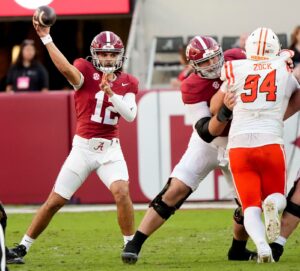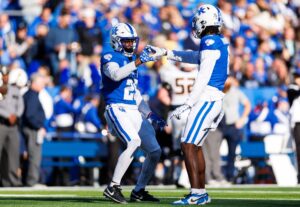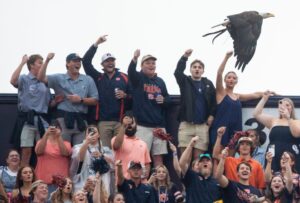Many will be evaluating CJ Stroud‘s first start against Minnesota after an up-and-down opener.
While Stroud started out well, he showed his youth and inexperience in the second quarter.
There were those on Twitter calling for Quinn Ewers, an even younger and more inexperienced quarterback, to play in place of Stroud.
His start wasn’t too shaky at the beginning. He completed two of his first three passes for 18 yards. The only incompletion in his first drive was a perfectly catchable ball to Garrett Wilson, which fell through his rain-slicked hands.
Stroud only completed two of six in the second quarter, causing people to wonder if the moment was too big for him.
But by the end of the game, he had 294 and four touchdowns. How much of his turnaround was his own, and how much was the team around him? When evaluating Stroud’s first start, we need to take all of these factors into account.
Evaluating Stroud’s First Start
A Victim of High Expectation
Fox showed a graphic of the last two Buckeye starters in their debuts, comparing their numbers to Stroud. Dwayne Haskins completed 22 of 30 passes against Oregon State, with 313 yards, five touchdowns, and one interception. Justin Fields made his Buckeyes debut against Florida Atlantic and threw eight incompletions to four touchdowns.
Evaluating Stroud’s first start against those of Haskins and Fields might be unfair. For starters, the other two quarterbacks were sophomores with around 40 passing attempts under their belts already. Stroud still hasn’t thrown that many passes yet, and he’s getting ready for his second career start.
Secondly, the debuts for Haskins and Fields were in Columbus, whereas Stroud was in Minneapolis.
Finally, Haskins played an Oregon State team that would go 2-10 (1-8 in conference play), defeating only Colorado and Southern Utah that year. Similarly, Fields played his first game against Florida Atlantic out of Conference USA.
Stroud by far had the hardest game of the three, and he had none of the experience going into it that the other two had.
It might be better to compare Stroud to the last two Ohio State quarterbacks in their first games against Power Five opponents. Braxton Miller and J.T. Barrett struggled mightily in their first such games, before going on to win the Griese-Brees Quarterback of the Year award a combined five times.
I would just like to point out the last two freshmen to start at quarterback for Ohio State against a Power 5 opponent:
Braxton Miller (@ MIA, 2011): 2/4, 22 yds, 0 TD, 1 INT
JT Barret (vs. VT, 2014): 9/29, 219 yds, 0 TD, 1 INT
Stroud will be fine— Nick Manchester (@NickManchester9) September 3, 2021
If this is the standard, then Stroud’s first start far exceeded expectations.
First Half Jitters
Stroud, contrary to what many expressed on social media, did not have a disastrous first half. He only completed half of his passes but didn’t put the ball in harm’s way very many times.
The only real play that was remotely dangerous ended in the interception. That throw was behind Chris Olave, which is what led to it being intercepted. But it was the right read, just a little bit mistimed.
When he did miss, he usually missed high. This is typically a sign of nerves, which makes sense given Stroud’s inexperience. The good news was when he missed, it was out of reach of defenders as well as receivers.
The biggest problem for Stroud was not accuracy but processing. The game looked just a little bit too fast for him, as he attempted passes since he was in high school. This was the first time he ever tried to pass against a college defense in a live game, and there is just no way to replicate that in practice.
His processing needed to catch up to the game, which resulted in mainly two problems for Stroud: making reads and pocket awareness.
In the beginning, Stroud saw too many moving parts for him to be able to make the reads he needed. There were four receivers running routes on any given play, in addition to eleven defenders to worry about.
He didn’t show a good awareness of pressure in the pocket, and he moved around when he didn’t need to. This resulted in making throws off-base or throwing the ball before the route had fully developed. He didn’t take any sacks thanks to the talented offensive line, but he also threw the ball before defenders even got close.
Second Half Adjustments
Ryan Day already had a game plan set up for Stroud’s first start, which included short passes and screens mixed with aggressive deep shots. During halftime, Day had to make some tweaks but dialed up a plan that helped Stroud have a monster second half.
First of all, Day didn’t bench Stroud. From our perspective, that’s something that should never have even crossed Day’s mind, unless the game was out of reach by the dying minutes of the fourth quarter. But Stroud, who only completed two of his last six passes, and had an interception that set up the go-ahead score for Minnesota, may have had concerns in the back of his mind. When he went back out in the second half, he knew the job was his no matter what, and that helped him settle down.
Secondly, Stroud had two carries in the second half. He only had one in the first, but it was when he stepped out of bounds to avoid a sack. In the second half, he had one scramble and one designed run. Whether Day encouraged Stroud to run more, or whether Stroud made that decision himself, it saved him from having to carry the game with his arm, which alleviated the pressure on him.
Third, he added a tight end or a running back to pass protection. This did two things: helped the offensive line and simplified Stroud’s reads. On an offensive line where only two starters returning from last season changed positions, having a tight end or back protect gave them some help, and it gave Stroud extra time. Secondly, it took away a read and simplified the game.
Finally, Day had Stroud roll out more in the second half. This cut the field in half, which limited Stroud to only one or two reads. It also kept him on the move so he wouldn’t feel uncomfortable in the pocket, and it bought him more time before Minnesota defensive linemen could catch him.
Second Half Results
In the second half, things slowed down for Stroud. The simplified game plan along with the strengthened pass protection helped deliver an explosive second half. Stroud completed five of his eight passes, with his last four completions resulting in touchdowns. Thanks to the explosiveness of the offense, Stroud has 236 passing yards in the second half.
Some might say the difference for Stroud was that Wilson and Olave were getting wide open in the second half. While that is true, Stroud hit them in stride for his first two touchdown passes. This turned big gains into touchdowns, as the passes were delivered perfectly to allow the receivers to keep running after the catch. Not to mention, Stroud didn’t overthrow them, which was a problem he had in the first half.
The fact that he overcame his tendency to overthrow shows that he settled in.
His best throw of the night might have been his 38-yard touchdown to Olave.
Ohio State comes out in the 2nd half & scores right away. Chris Olave was left open on the crossing route & CJ Stroud takes advantage. The Buckeyes regain the lead.
OHIO STATE 17
MINNESOTA 14https://twitter.com/CFBONFOX/status/1433611104350052353?s=20
Stroud had a defensive lineman bearing down on him, but he stood there and delivered. He floated the throw right above the defender and put the ball right where Olave wanted it.
While Stroud was able to salvage the game, he might have cracked if it wasn’t for the support system around him. Day is a great quarterback coach, so he was able to change the game plan to help his freshman quarterback. Olave and Wilson are two of the best in the game, as well as the great stable of running backs the Buckeyes can lean on. Of course, the offensive line looked dominant, so Stroud was never under much pressure from start to finish.
Stroud just needs to get comfortable. He did a lot of growing against Minnesota, and he looked like a different player in the second half.
Up next for Ohio State is Oregon, an opponent against which Stroud will have to be dialed in. He can’t have a jittery first half against the Ducks.






